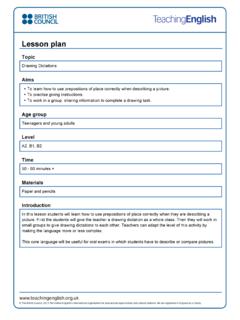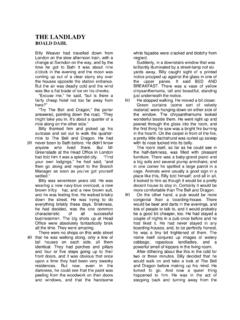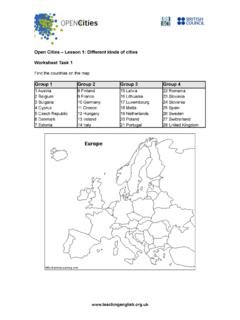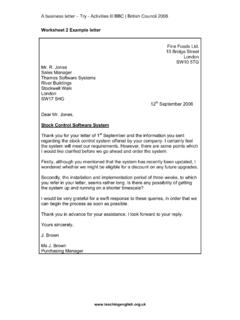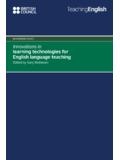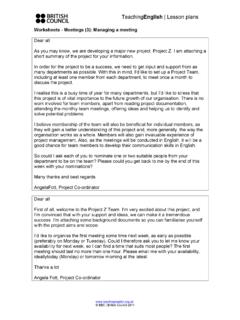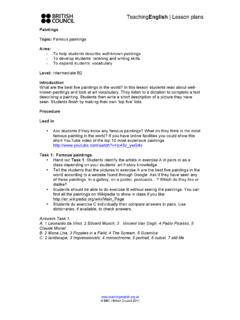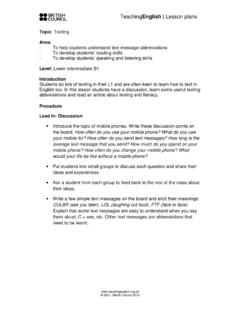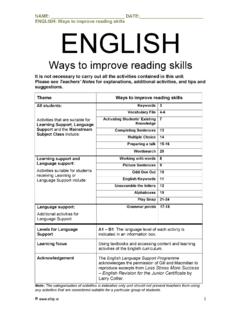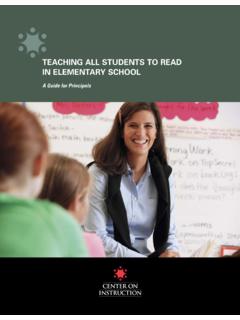Transcription of Teaching Reading and Writing - TeachingEnglish
1 Reading and WritingReading skills Mat WrightLearning outcomesThis module focuses on Teaching Reading and equipping learners with the skills of Reading . By the end of the module you will be able to: recognise a range of skills for effective Reading identify activities that can be used to practise these specific skills explore other techniques for improving Reading Before you watcha. What skills do you need for effective Reading ? Think about when you read in your own language and also in English?Try to compare your answers with a Do you know what these Reading skills are? inferring skimming scanning Match each one to the definitions taken from the British Council s TKT Reading a text quickly to pick out specific Reading a text quickly to get a general idea of what it is deciding how a writer feels about something from the way that they write rather than the words they Reading and Writing Reading skills2 TeachingEnglish British Council 20152 Reading skills adviceWatch and listen to the commentary at the beginning of Reading skills : Part 1 (00:00 to 01:06).
2 Then pause the video and answer the following What Reading skills does the trainer mention? b. Finish the following sentences according to the trainer s advice. The reason that we read affects _____ ____ _____. We need to work with our students to _____ _____ ____. We also need to show them _____ ____ ____ ____ _____ ____ _____ _____. We also need to ask comprehension questions and conduct activities that _____ _____ ____. Reading skills practiceWhat does this advice mean in practice? Complete the following Reading activity and afterwards we will analyse the Reading skills that you On the following page is a Reading text about learning styles. Don t read it yet, instead make a note below about what you know about learning Look quickly (25 seconds maximum) at the Reading text on the next page.
3 What is it about?c. Quickly look again at the Reading text on the next page. Which three learning styles are mentioned? Teaching Reading and Writing Reading skills3 TeachingEnglish British Council 2015 Learning stylesWe all learn in different ways. One theory of learning focuses on the way information is given to learners and refers to visual, auditory and kinaesthetic learners. Visual learners respond well to pictures, colours, images. They need to see things to help them learn and remember. Auditory learners learn best by hearing things. Kinaesthetic learners like movement. They need movement and hands-on tasks to help them any class we teach, the learners will have a range of learning styles. This means that to help all of our learners learn we have to use a range of classroom activities and techniques so that different styles of learner are interested and can learn from our from: British Council (2008), Teaching SpeakingRead the text in more detail and answer the following questions.
4 The first one has been done as an Who is the text written for and how do you know that?The text is written for teachers. It says we teach, our class and our lesson as well as using Teaching jargon such as activities and What do you think the expression hands-on means? What helped you to guess?f. In the final sentence what does this refer to?g. Is the theory outlined commonly accepted as the main theory of learning styles? Does the writer consider it the main theory? Please give reasons for your What is the main point that the writer wants to convey? How do you know that? Teaching Reading and Writing Reading skills4 TeachingEnglish British Council 2015i. This is the first part of a text on learning styles. What do you think second part will be about?
5 Try to compare your answers with a partner and then check them with the answer section at the Reading skills analysis1. We are now going to look at the questions again and think about their purpose. Each one practised one of the Reading skills listed in the box below. Match each Reading skill to each question. The first one has been done for you as an linksestablishing context for readingguessing meaning from contextidentifying the target audienceskimmingidentifying the main messageQuestionReading skilla. On the following page is a Reading text about learning styles. Don t read it yet, instead make a note about what you know about learning context for readingb. Look quickly (25 seconds maximum) at the Reading text on the next page. What is it about?
6 C. Quickly look again at the Reading text on the next page. Which three learning styles are mentioned?d. Who is the text written for and how do you know that?e. What do you think the expression hands-on means? What helped you to guess?f. In the final sentence what does this refer to?g. Is the theory outlined commonly accepted as the main theory of learning styles? Does the writer consider it the main theory? Please give reasons for your What is the main point that the writer wants to convey? How do you know that?i. This is the first part of a text on learning styles. What do you think second part will be about? Teaching Reading and Writing Reading skills5 TeachingEnglish British Council Practising Reading skillsa. Watch the next sequence of Reading skills : Part 1 (01:22 to 08:24).
7 You will see specific Reading skills being practised. Put the activities below in the order you see them. Scanning a text for specific the meaning of words from the the content of a a text for the main a text type and the purpose for the context for a Reading Watch and listen again. How does the teacher in sequence four (04:47 to 05:33) cater for different learning styles? Teaching Reading skillsa. Watch the final sequence of Reading skills : Part 1 (08:39 to 10:57). The teachers talk about how they teach and provide practise for Reading skills . Which of their tips have you seen in the video? b. What other tips and techniques do they mention? c. Which tips and techniques could you use with your classes? Put a tick ( ) in the right hand column of each Reading and Writing Reading skills6 TeachingEnglish British Council Reading skills further practicea.
8 Watch Reading skills : Part 2 (00:00 to 16:03). What activities does the teacher use to practise each Reading skill? Complete the skillActivity1. Establishing the context of the Reading text. (00:24 to 02:30)2. Predicting the content. (02:31 to 04:30)3. Skimming for main ideas. (04:30 to 07:20)4. Scanning for specific details. (07:20 to 09:22)5. Guessing the meaning of vocabulary from the context (09:22 to 16:03) Teaching Reading and Writing Reading skills7 TeachingEnglish British Council 20153 ReflectionThink about the next few classes that you are going to teach. If you use a coursebook, look at the next Reading Analyse the Reading tasks through the following questions: 1. Are there tasks for learners before, during and after Reading ? 2. Are there are a range of tasks that appeal to different learning styles?
9 3. What Reading skills do the tasks practise? 4. How can you make these skills explicit to learners and help them identify how to improve their skills ?b. How could you adapt and/or supplement the tasks to match your learners needs? Are there any techniques from this module that you could use and try out? Teaching Reading and Writing Reading skills8 TeachingEnglish British Council 2015 Transcripts and answersTranscript s of trainer s Reading skills adviceThe reason that we read affects how we read so for example if we are following instructions we will read differently than if we are Reading to find out are a number of skills involved in Reading for example predicting, skimming, scanning and recognising links. We need to work with our students to analyse what these skills are and also to show them how they can get better at these skills .
10 We also need to ask comprehension questions and conduct activities that will practise these specific let s look at some examples of activities that practise a range of Reading skills . Watch the films and make notes to answer the questions in the viewing task. The answers will appear at the end of the Teaching Reading skillsLet s listen now to some tips. Watch the interviews and make notes to answer the questions in the viewing task. The answers will appear at the end of the the next stage students read the text again, this time scanning for details. The teacher writes numbers on the board and asks students to find their significance in the text. This activity encourages students to scan the text for specific information, allowing them to gain more in-depth understanding of the Reading and Writing Reading skills10 TeachingEnglish British Council Reading skills further practiceIn this lesson you ll see how a range of Reading skills is practised in one Reading lesson.
